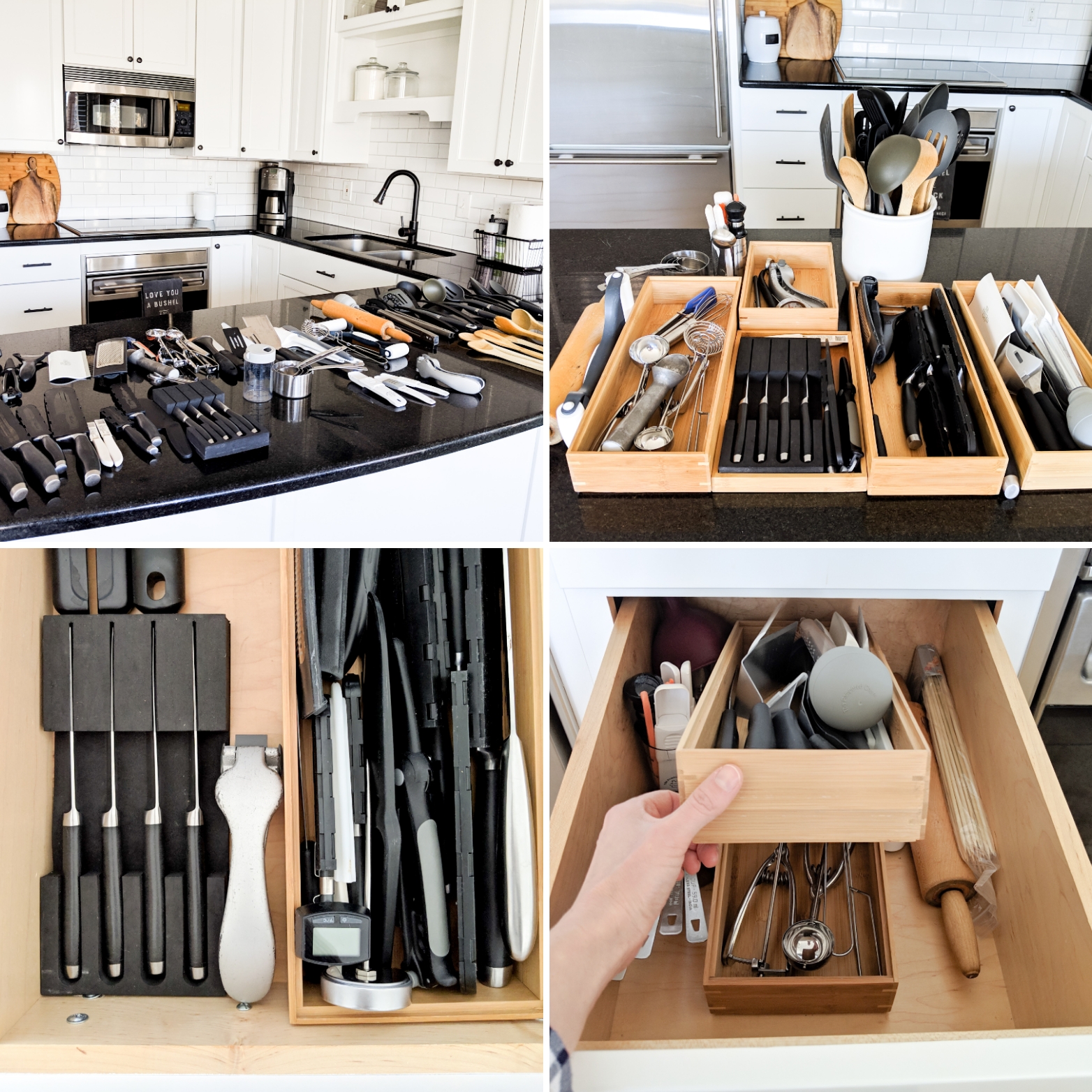7 Tips for Organizing Your Kitchen
/The kitchen is the hub of our home. It’s not just where we are cooking meals, it’s a gathering place, a drop zone, sometimes it’s even our home office. This multipurpose space can be a challenge to keep clean and organized.
Does your kitchen always look messy? Do you struggle to find the cooking utensils you need? Are your plastic containers in a jumbled pile taking up valuable cabinet space? Well, you’ve come to the right place! You can get your kitchen organized—I’m here to help. Let’s get started.
1. Rarely Used Items
These items vary person to person so use your best judgement when deciding which items fall into this category. For me, this includes my largest stock pot, electric roaster, glass jars, and nice serving dishes.
Store small items that fall into this category on the highest shelves of your cabinets. Preserve the eye-level shelves for your most frequently used kitchen items like plates and bowls.
If your kitchen, like mine, doesn’t have an abundance of storage space consider storing large, rarely used items outside of the kitchen. There is likely a great place for these items in your pantry, garage, or basement. My stockpot and electric roaster only get used once or twice a year so they are stored on the highest shelves in our pantry.
2. Plastic Containers
After removing all plastic containers from their storage space, set aside anything that doesn’t have a matching lid or that you rarely use to be trashed, donated, or repurposed. Personally, I dislike these containers as a food storage option and only have a few left in my kitchen, but you do you!
Your keep pile should be neatly stacked from largest to smallest. If you are unable to easily stack the lid under its matching container, utilize one container (maybe one from your discard pile!) to hold the lids uprights so they are easy to flip through when making your selection.
3. Cooking Utensils
Spread out all of your utensils on the countertop. Woah—right? Start by eliminating any utensils that you don’t use, that are broken, or those that have too many duplicates—no one needs six pancake turners—just keep your favorites.
I love the use of a utensil crock for items I use frequently. For the utensils you plan to store in a drawer, use dividers and organizers to keep things easy to find. I love stackable wooden organizers because they give your kitchen a clean, custom look while maximizing storage space. If you want to avoid the extra cost of drawer organizers, any container can work—look through the plastic containers in your discard pile!
4. Pots & Pans
Pots should be stored with their lid in place. If you put the lid on upside-down, you are able to stack pots on top of one another. If you don’t have enough clearance in your cabinet or drawer to stack this way, go ahead and just stack the pots together, then use another container (remember that pile of plastic containers!) to store the lids upright so you can easily find the one you need. Please note: when storing non-stick pots this way it’s best to use pot protectors or even old dishtowels to protect the cooking surface from damage.
If you have space to store your pans vertically, I envy you, utilize that space! If, like me, you need to stack, just remember to keep your most frequently used pans on top. I don’t bake as often as my children would like so my muffin tins and cooling racks live at the bottom of my stack.
5. Spices
Start by emptying and wiping out your spice cabinet. Throw out any expired spices or any that you’ve had over 4 years—I know that seems absurd, but those spices have a way of lingering around longer than you think! If you have duplicates, combine them if possible, otherwise store them on a higher shelf until you are ready to make the replacement. For an extra clean look, transfer your spices into clear jars and label with a chalk marker. Utilize a spice rack or tiered spice shelf so that all labels are readable. Some people prefer to use a shallow drawer, which is a great solution if your space allows.
6. Under the Sink
Start by getting everything out from under the sink! Are you sensing a theme here? It’s much easier to sort, organize, and start fresh when you have an empty space in front of you.
Only keep items that pertain to the kitchen. The bathroom cleaner should probably go in the bathroom, and lets put the bug spray in the garage or basement. Kitchen related cleaners, dish detergent, and trash bags are all just fine to stay.
Typically there’s a lot of height to work with in the under-the-sink cabinet. I use a wire shelf to take advantage of this vertical space.
Do you save plastic bags? They can be great for collecting trash in the car, walking the dog, small trash can liners, and much more. I love using baby puff snack containers to keep plastic bags handy (they fit in cupholders!), but you could use an empty baby wipes or cleaning wipes container, or buy a container specifically made for the job.
7. Countertops
Decluttered countertops are the key to a kitchen that looks and feels really clean! My rule: if it’s not used daily it doesn’t need to sit on your countertop. The blender, food processor, and toaster can all be stored within your cabinets. These larger kitchen items fit well inside corner cabinets and Lazy Susan cabinets.
Is your kitchen a drop zone for mail or homework? Paperwork can easily clutter up your countertop space. I recommend using a basket to contain papers. A basket is easy to grab when you have the time to properly sort and file the papers—in the meantime, the mess is contained.








